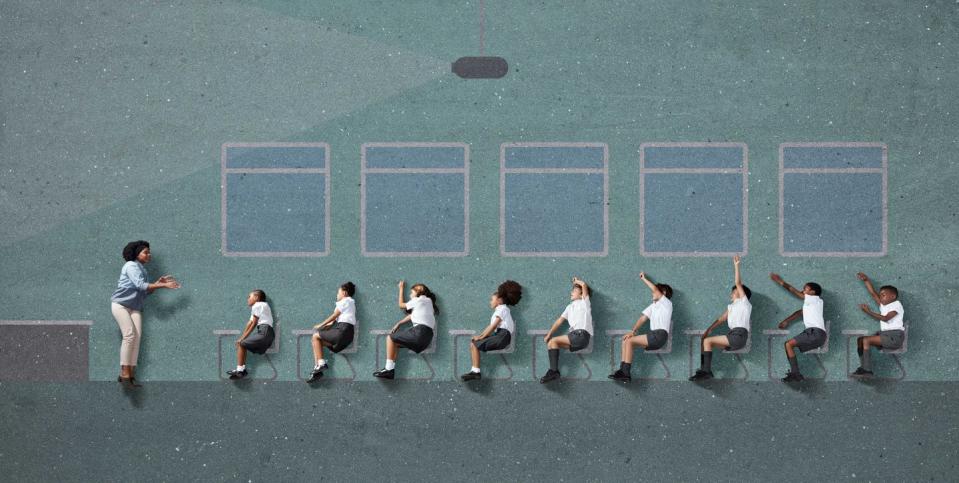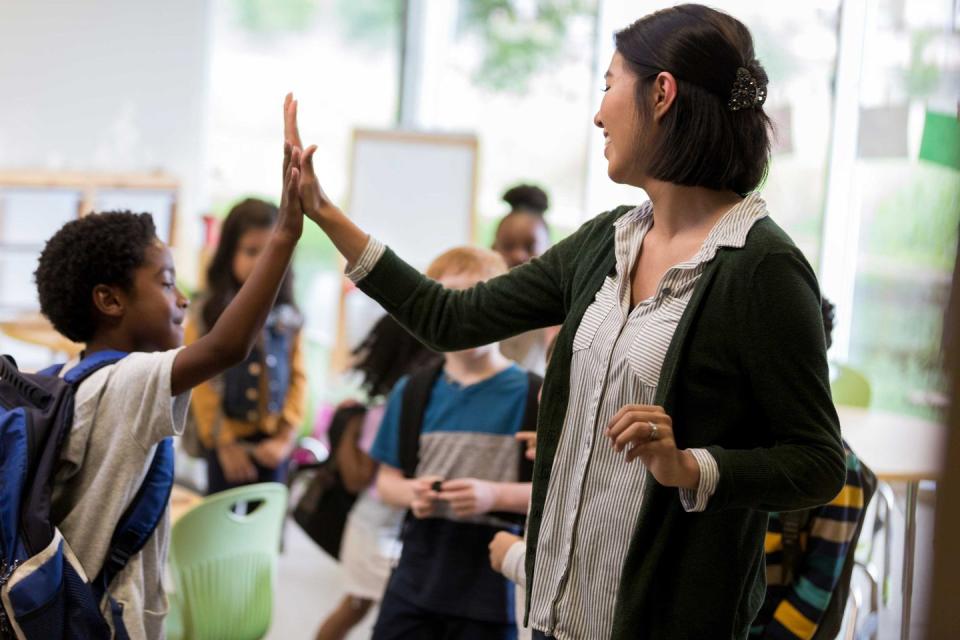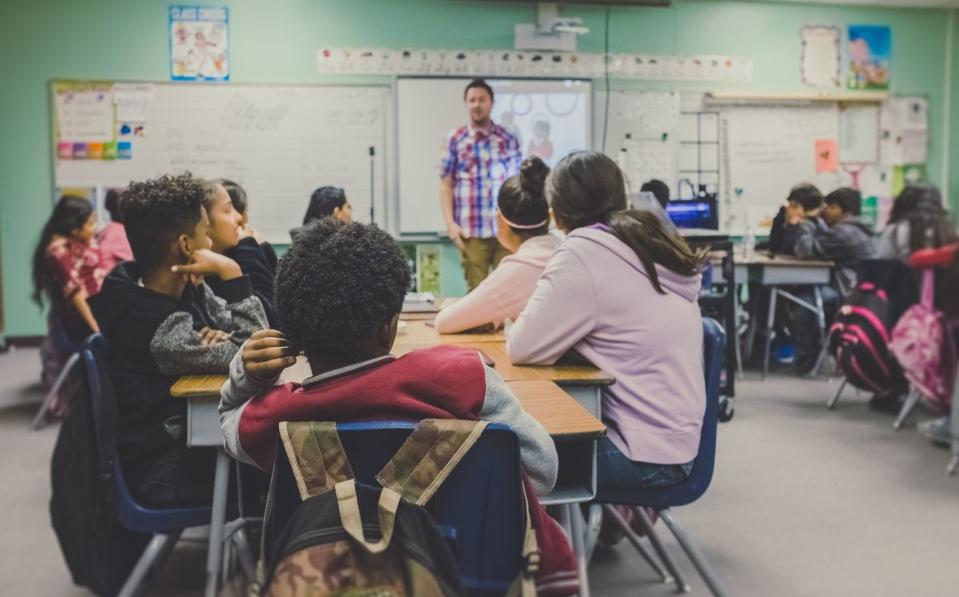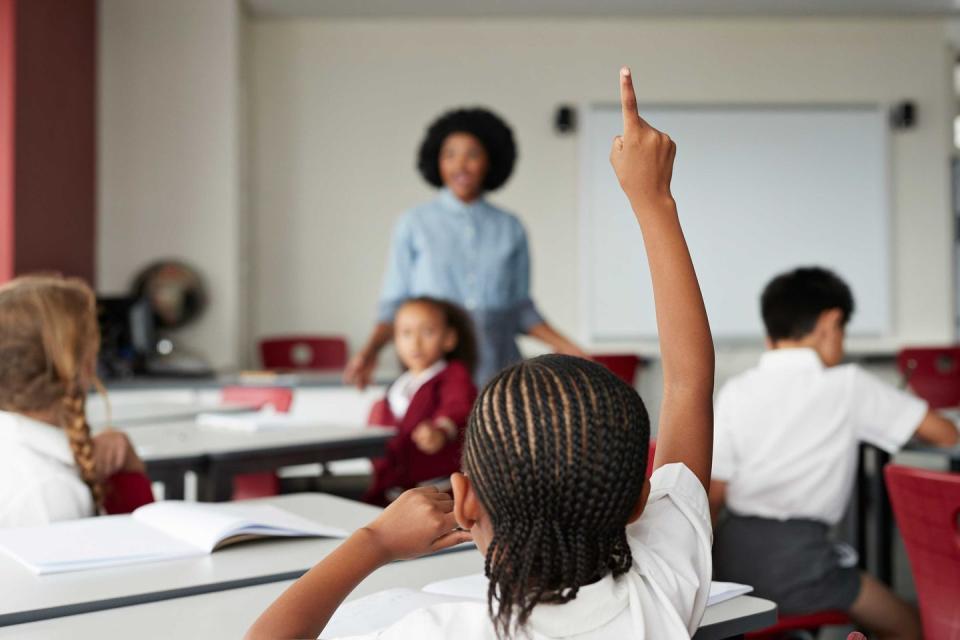What It’s Like To Teach At The Lowest Ranked School In New York City

Miss V knew she wanted to teach since she was five years-old. As a child, she set up a pretend classroom in her basement and has been training for the job ever since. "More than anything, it is the genuine love, words, and energy of encouragement, and emotional support students feel that give a classroom a heartbeat," she tells me.
Taking a job at the lowest ranked school in New York City, her positivity and drive to teach didn’t fade with her classroom of nine kindergarteners. Miss V and I discuss challenges, lessons learned, and navigating the politics outside of the classroom, always with her students as the top priority...
Attendance, test scores, and observations rule the school.
With low attendance, the school of 200 students (kindergarten through fifth grade) could shut down. Students understood this and would purposefully lash out against their classmates and disrespect teachers, knowing that they wouldn’t be suspended or properly reprimanded, arriving at school the next day.
The looming stress of test scores only added to the pressure of the overwhelming curriculum and tense school days. Like finding a loophole in a system, the curriculum was designed to pass state tests, rather than making the classroom learning experience meaningful. Miss V says, "These pressures are distractions limiting the learning, and the curriculum itself has little personal connection to the students. The third to fifth grade teachers and students feel it hardest as testing grades."

The principal would drop in daily, unannounced with an eagle eye. She would essentially hold the teachers at will with threats of bad observation scores. "Teachers felt trapped as their reputations were associated with the school’s failing test scores. For many teachers who expressed interest in leaving, the principal would not sign them off to work in a different school. They could not get a job elsewhere because they needed this permission from the principal. She knew that one tainted observation could ruin someone’s teaching career," Miss V explains.
Teachers are responsible for funding academic celebrations, awards, or parties.
Working with children as young as five years old, it’s important to celebrate their accomplishments big or small as part of the motivation process. Unfortunately at this school, teachers are not supported much in this. Miss V tells me, "The saddest thing for me is that there are no scheduled award ceremonies or academic celebrations, and these are the students who need them most. Reading move-ups, math breakthroughs, and writing 'publications' should be celebrated weekly or at least monthly. If we wanted to host anything, we had to pay for it ourselves and squeeze it into our already packed day. We are bound to such a strict schedule where if my principal arrived unexpectedly for an observation at 9:30 AM when reading was supposed to start, and I was still finishing up math, I would get marked down. If we ever fell behind schedule, we had to send an email explaining our shortcomings and solution plan. I needed to set timers throughout every subject, which was so distracting and made it difficult to flow creatively."

Social workers are needed just as much as teachers.
"40% of the students at this school come from temporary homes. Social workers are needed just as much as teachers because these kids come in with so much trauma. Students are living in shelters, foster homes, and packed apartments with extended family. My one kindergarten boy couldn’t stay awake in school one week. His family had just moved into a shelter, and there was a rat beneath his bed making noise all night. There were some bunkmates yelling and fighting all night too, he explained. He was scared and tired. How could he possibly focus on counting numbers when this trauma plagued him? Yet, he was expected to learn, and I was expected to teach him," Miss V says.

Having social workers to handle fights and outbreaks is not enough; they need space and time to take preventative measures to help students properly process their trauma, rather than just reacting to the most severe cases. "Restorative circles and therapy sessions need to be essential components of the school day for all students, not just for the ones exhibiting outwardly negative behavior. Cries for help come in many different forms”, she says. Students exhibited poor behavior because they knew it would get them out of class, where they could talk to a social worker, color, and play with toys.
Miss V explains, "Social workers would come into my classroom only after an emergency would occur. My kindergarteners quickly learned that if they made a scene a woman would come, and they could get out of doing their classwork. Once a student snuck a jump rope in. He became upset about doing his math worksheet and began whipping me and other students. He then threw books and chairs. Social workers shouldn’t just be reacting to bad behavior. Their therapeutic work should be a daily part of our school days.”
The students need more than math and reading.
The school is surrounded by project buildings, with a playground lined with barbed wire fences. Most of the kids live in and around the projects. Miss V’s fellow coworker who taught at the school grew up in those buildings and connects with the students on a cultural level. As a Greek American with a suburban upbringing, Miss V isn’t able to as easily connect with them on a cultural level, but led daily activities to give students time and space to find their voices.

Miss V says, "I learned the value of restorative circles, which we called Power 30 for 30 minutes every morning to start our day on a positive note. I made sure each student had personal space for their breakfast and backpack and would ensure no one’s back was to another. We talked about how we were feeling each morning. Did we see something beautiful on our way to school? Did we see something upsetting we could unpack together? Coming from broken homes, we talked about our heroes and our fears. I got to know their personalities and preferences. I was supposed to be doing reading and writing with them, and we did that, but it was so much more about the socio-emotional needs of the kids that became priority."
Staff and students do not feel safe.
Led by the demeaning tone of the principal, the staff was divided instead of united. The rules were unclear and inconsistent, and staff and students did not feel safe in the building. Miss V adds, "Teachers would avoid passing the principal’s office, and the teachers' lounge across from her office was often empty, as staff knew administration could easily listen in on conversations. She asked me uncomfortable questions about the performance of my co-teacher. My priority was to teach my five-year-olds how to read and write, and these questions caused distraction and unease."

Bullying and violence among students sadly happens often, and it's heartbreaking. When security is called, it can take more than five minutes for them to arrive. "Teachers have been hit, bitten, and whipped with a jump rope. The first thing we are asked is, 'What could you have done better as a teacher?' Coming from unsafe homes, many of these students are victims of abuse and neglect. I had a basketball thrown hard at my nose by an angry student who had been put into foster care, separated from his mother and brothers. Students are not punished when they lash out as their attendance is imperative. In December, I needed backup in the hallway with three students kicking and attacking each other. They were running up and down the hallway. This was the hallway where the principal's office is, and when I popped my head in for back-up, the principal and vice principal were unsupportive and shut the door on me. They just expected us to deal with it," she explains.
Miss V was threatened when she tried to resign.
Miss V set up a meeting with administration and gave a month and a half notice of resignation, planning to finish out the 2019 school year. "I had already let my co-teacher know, and she supported my decision. I respected my coworkers and loved my students, but I felt unsupported and unsafe in this environment. I realized why this school had been failing for years. I was mentally and physically exhausted. I did not want to become trapped in this school, as many of the teachers expressed they were. When I carefully brought my concerns up to my principal and put in my resignation, she warned me, 'If you decide to leave here mid year, I am telling you, you will never get a teaching job again,'" Miss V says.

A few days after this intense and uneasy meeting, the principal changed her tone and offered a deal for Miss V to only work four days a week at the school, saying on the fifth day she could head to campus to work on her studies at Columbia University. The principal promised classroom coverage and the same salary for her to finish the year and complete her graduate research. "After looking into this, I found out these offers were illegitimate and were off-the-record for a reason," she adds.
Miss V leaves me with this, "Being present for my students is always my top priority. We must be vulnerable and make space for one another. This teaching experience made me realize more than ever that context matters deeply when it comes to the needs of the teachers and students. We need to be heard, supported, encouraged, and celebrated. Administrators and teachers must be on the same team, working together to attend to a school's needs. Administration must support teachers so that teachers can best support students. We must stand up for ourselves and our students. These are lessons I will take into my future classrooms and schools."
You Might Also Like

 Yahoo News
Yahoo News 